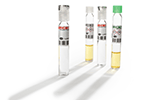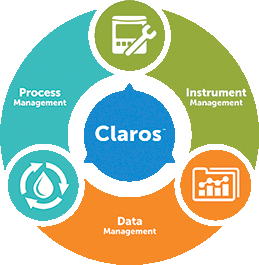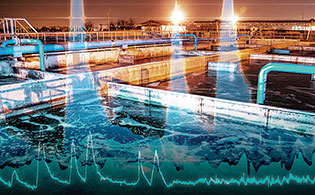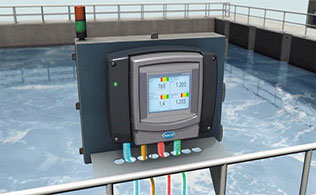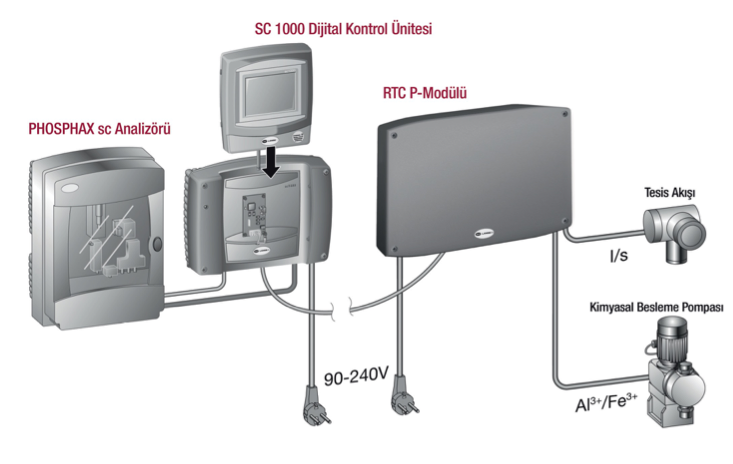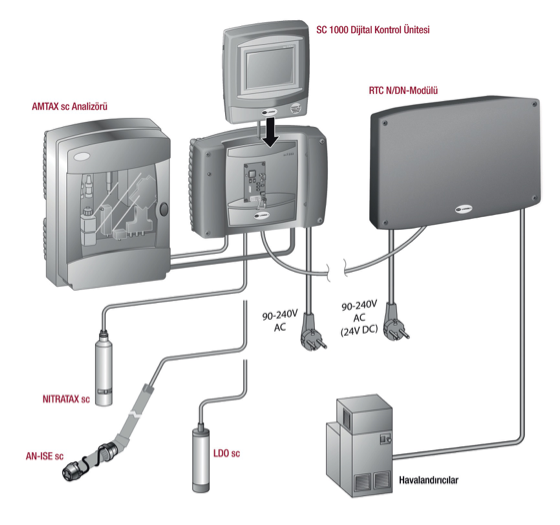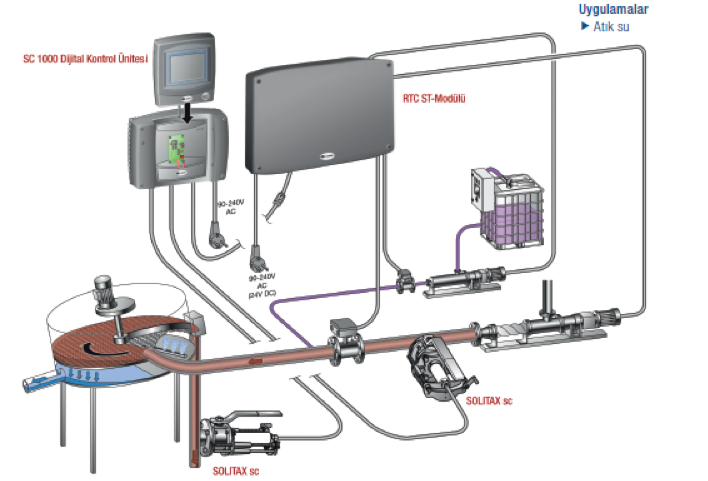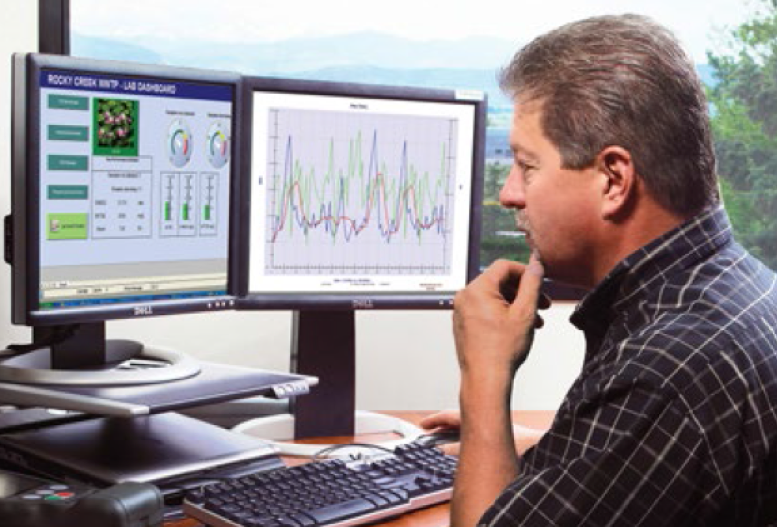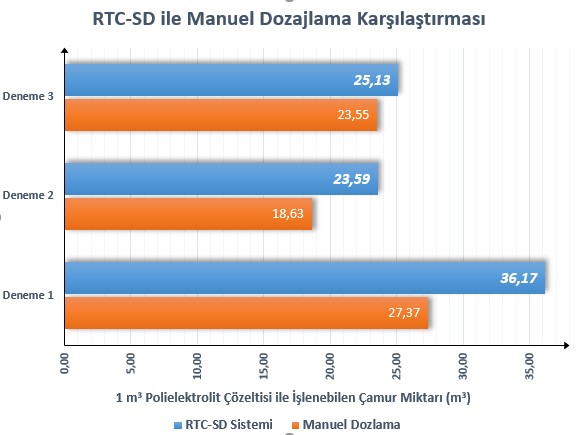-
Ürünler
-
Laboratuvar Cihazları
-
Laboratuvar Ölçüm Cihazları ve Problar
Diğer Ölçüm Cihazları Kalibrasyon Standartları
- Kimyasallar, Reaktifler ve Standartlar
-
Online Analysers
EZ Series Analysers
- Iron
- Aluminium
- Manganese
- Phosphate
- Chloride
- Cyanide
- Fluoride
- Sulphate
- Sulphide
- Arsenic
- Chromium
- Copper
- Nickel
- Zinc
- Ammonium
- Total Nitrogen
- Total Phosphorus
- Phenol
- Volatile Fatty Acids
- Alkalinity
- ATP
- Hardness
- Toxicity
- Sample Preconditioning
- Boron
- Colour
- Nitrate
- Nitrite
- Silica
- Hydrogen Peroxide
- EZ Series Reagents
- EZ Series Accessories
- EZ sc Series Inorganics
- EZ sc Series Metals
- EZ sc Series Nutrients
-
Online Sensörler ve Kontrolörler
pH ve ORP Sensörleri
- 1200-S ORP
- 1200-S pH
- 12mm pH/ORP
- 8362 sc Yüksek Saflık
- Dijital Diferansiyel ORP
- Dijital Diferansiyel pH
- Kombine pH/ORP
Numune Şartlandırma Organikler Askıda Katı Maddeler Çamur Seviyesi - Numune alma
- Otomatik Laboratuvar Sistemleri
-
Claros Water Intelligence System
Data Management
- Claros Collect
- Test Setleri ve Çubukları
-
Mikrobiyoloji
Aksesuarlar ve Kimyasallar CihazlarHazırlanan Ortam
- BARTS
- MUG Tüpleri
- Maya ve Küf
- Membran Filtrasyon
- Paddle Testers
- Sıvı MPN
- Toplam Sayım Ortamı
- Var-Yok
-
Laboratuvar Ekipmanları ve Tedarik
AparatCihazlar Genel Laboratuvar Sarf MalzemeleriCam Eşyalar/Plastik Eşyalar
- Elektrokimya
-
Laboratuvar Cihazları
- PARAMETRELER
-
Yazılım çözümleri
-
Claros Water Intelligence System
ÜRÜN GRUPLARI Process Management
- Çözümler:
- BOİ/KOİ Giderimi
- Nitrifikasyon/Denitrifikasyon
- Fosfor Giderimi
- Çamur Yönetimi
Data Management- Çözümler:
- Toplama
- Görünürlük & Analiz
- Raporlama
- Veri Doğruluğu
Instrument Management- Çözümler:
- Bakım
- Sorun Giderme
- Uzaktan Erişim
- Lab ve Proses Karşılaştırması
Endüstriyel Zorluklar Mevzuatlara Uygunluk Maliyet Tasarrufu Uzaktan İşletim Veri Yönetimi Proses Optimizasyonu Ekipman Bakımı
-
Claros Water Intelligence System
- Endüstri
- Servis
- Haberler ve Etkinlikler
Türkiye
Ülkenizi ve bölgenizi seçin:
Europe
Americas
Asia - Australasia
- Australia
- Mainland China
- India
- Indonesia
- Japan
- Malaysia
- New Zealand
- Philippines
- Singapore
- South Korea
- Thailand (Thai)
- Taiwan
- Vietnam
Middle East - Africa
KARİYER +90 (0) 312 490 83 00
Claros Process Management
Şunlara yönelik çözümler:
Sürekli proses yönetimi, arıtma proseslerinizi gerçek zamanlı yönetmenizi sağlar. Tesisin hem 7/24 verimli çalıştığından hem de yönetmeliklere uyduğundan emin olun. Prosesinizi yönetmek hiç bu kadar basit olmamıştı.
Claros Çözümlerini İnceleyin
- Instrument Management
- Data Management
- Process Management
Hangi prosesleri geliştirmek istiyorsunuz?
Prosesinizle ilgili daha gerçek zamanlı görünürlüğünüz olsun ister miydiniz?
BOİ/KOİ giderimi hakkında uyumluluk endişeleriniz mi var?
Uyumluluk endişelerine yol açan çamur çökeletme sorunlarınız mı var?
Havalandırma enerji maliyetlerinizi düşürmek istiyor musunuz?
Sabit bir karıştırılmış sıvıda askıda katı madde (MLSS) değeri mi hedefliyorsunuz yoksa çamur tutma süresini (SRT) mi ayarlıyorsunuz?
Akış, TOK, ÇO ve MLSS gibi gibi gerçek zamanlı verilere dayanarak Claros Process Management sistemleri, gerçek giriş suyu yükünü ve tesis koşullarını sürekli olarak izler. Uyumluluğu korumak ve tesisin 7/24 verimli çalışmasını sağlamak için bu değerlendirmelerin kullanılmasıyla harici nütrient kaynaklarının dozlanması, havalandırma yoğunluğu ve çamur tutma süresi dahil olmak üzere dinamik ayar noktaları hesaplanır.
İlgili Çözümler:
Nütrient Dozlaması (RTC-C/N/P)
Doğru C/N/P dengesine sahip olmak biyolojik atık su arıtma açısından kritik önem taşır. Hach'ın RTC C/N/P sistemi, endüstriyel atık su arutma tesislerindeki üre ve fosforik asit gibi nütrientlerin dozlamasını optimize ederek KOİ/BOİ, NH 4 ve PO 4'ün uyumluluğunu sağlar. Çıkıştaki deşarjın ve eklenen kimyasalların maliyeti, mümkün olan en düşük seviyeye indirilir.
Çamur Tutma Süresi (RTC-SRT)
Havalandırma havuzunda Çamur Tutma Süresi'nin ve Karıştırılmış Sıvıda Askıda Katı Madde seviyesinin doğru olması, uyumluluk ve enerji tasarruflu arıtma açısından son derece önemlidir. Hach'ın RTC-SRT sistemi, ideal SRT ve MLSS konsantrasyonu ile stabil bir BOİ/KOİ giderimini ve istenmeyen Nitrifikasyonun ortadan kaldırılmasını sağlamak için atıktaki aktif çamuru otomatik olarak ayarlar.
Çoğu Açık Valf ÇO Kontrolü (RTC-MOV)
Enerji tasarruflu havalandırma sistemleri (havalandırıcı ve valfler), manifoldda proses havasını minimum hava basıncıyla ve hava valflerinde minimum basınç kaybıyla besleyip dağıtır. Hach RTC-MOV sistemi, karşılık gelen hava valfi konumları ve manifold basıncı (veya hava akımı) için ayar noktaları sağlayarak en fazla 16 farklı bölgede ÇO konsantrasyonunu kontrol eder. Bunun sonucunda maliyetler azalır ve kullanılabilir proses havası gereken yerlerde en üst düzeyde olur.
Değiştirilebilen Çözümler
İhtiyaçlarınızı tam olarak karşılayan bir çözüm göremediniz mi? Özel zorluklarınıza yönelik olası seçenekleri görüşmek için bizimle iletişime geçin.
Do you wish you had more real-time visibility into your process? Do you know your maximum nitrification capacity and what rate is required right now?
Do you have compliance concerns around ammonium or total nitrogen treatment?
Are you applying static DO concentrations or do you adjust based on load?
Are you applying fixed aeration/amoxic times or volumes, or are you adjusting based on actual purification requirements?
Do you target fixed mixed liquor suspended solids (MLSS) or are you adjusting sludge retention time (SRT)?
Based on real-time data like those for flow, NH 4-N, NH 3-N, DO and MLSS, Claros Process Management systems continuously monitor the actual inflow load and plant performance. Using those evaluations, dynamic set points -- including those for DO concentrations, aeration intensity, internal recirculation, anoxic time or sludge retention time – are calculated to safeguard compliance and ensure efficient plant operation 24/7.
Relevant Solutions:
Nitrification and Denitrification through On/Off control (RTC-N/DN)
Meeting Total Nitrogen (TN) limits in the effluent of intermittent operated plants can be very challenging. Varying inflow conditions can hardly be managed with fixed time periods for nitrification and denitrification. The RTC-N/DN system determines optimal times for nitrification and denitrification based on the continuous measurement of NH 4-N and NO 3-N. Through this, Nitrogen elimination is maximized while aeration energy is minimized.
Sequencing Batch Reactor (SBR) (RTC-N/DNSBR)
Meeting Total Nitrogen (TN) limits in the effluent of intermittent-operated plants can be very challenging. Varying inflow conditions can hardly be managed with fixed time periods for nitrification and denitrification. The RTC-N/DNSBR system, designed for intermittent operated sequencing batch reactors, determines optimal times for nitrification and denitrification based on the continuous measurement of NH 4-N and NH 3-N. Through this, Nitrogen elimination is maximized while aeration energy is minimized.
Simultaneous Nitrification/Denitrification (RTC-SND)
Meeting Total Nitrogen (TN) limits in the effluent of plants utilizing simultaneous nitrification can be very challenging. Varying inflow conditions can hardly be managed with fixed volumes for nitrification and denitrification. The RTC-SND system determines the optimal aerobic and anoxic volume based on the continuous measurement NH 4-N and NH 3-N. Through this, Nitrogen elimination is maximized while aeration energy is minimized.
Nitrification (RTC-N)
Meeting the NH 4-N limits in the effluent of a nitrifying plant with plug flow reactors can be very challenging. Varying inflow conditions can hardly be managed with a fixed DO concentration in the aeration tank. Based on the measured NH 4-N inflow load and NH 4-N effluent concentration the N-RTC calculates DO setpoints ensuring immediately reaction on inflow load changes and precise control of the NH 4-N effluent concentration to a desired setpoint. Through this, compliance on NH 4-N is ensured while aeration energy is minimized.
Most Open Valve DO Control (RTC-MOV)
Energy efficient aeration systems (blowers and valves) provide and distribute the process air at a minimum air pressure in the manifold and a minimum pressure loss across the air valves. The Hach RTC-MOV system controls the DO concentration in up to 16 different zones by providing set points for the corresponding air valve positions and for the manifold pressure (or airflow). The result is reduced costs and maximum available process air where it is needed most.
Denitrification (RTC-DN)
Meeting Total Nitrogen (TN) limits in the effluent of wastewater treatment plants requires the best usage of the available denitrification capacity. For plants with internal recirculation this means only a minimum of DO has to be carried over from the nitrification to the denitrification zone. This can hardly be achieved with a fixed or inflow proportional internal recirculation flow rate. Designed for plants with internal recirculation the RTC-DN system ensures that the available denitrification capacity is utilized by controlling the NH 3-N concentration effluent denitrification or effluent aeration to a desired setpoint. If required, dosing of external carbon sources can also be controlled to support denitrification. Through this, compliance on TN can be supported while potential costs for external Carbon are minimized.
Denitrification - Swing Zone (RTC-SZ)
The swing zone controller works in conjunction with the RTC-N to provide maximum available DN volume. Then, the plant load allows nitrification volume to be safely reduced. Zone 1 of an aeration lane can be reliably switched to anoxic, greatly increasing the denitrification potential of a plant. Alternatively, this can be used to introduce/extend a selector zone into plants to help improve sludge settleability.
Sludge Retention Time (RTC-SRT)
A correct Sludge Retention Time and MLSS level in the aeration basin are fundamental for compliance and energy efficient treatment. Hach’s RTC-SRT system automatically adjusts the waste-activated sludge to provide the ideal SRT and MLSS concentration, thus ensuring stable Nitrification all year around.
Modified solutions
Not seeing a solution that exactly meets your need? Contact us to discuss potential options for your specific challenges.
Do you wish you had more real-time visibility into your process?
Are you adding chemicals based on static dosing rate or are you adjusting according to load?
Do you have compliance concerns with load peaks?
Do you foresee lower permit requirements on the horizon?
Are there times you struggle with biological phosphorus removal (Bio-P)?
Based on real-time data like those for flow, orthophosphate or total phosphorous, Claros Process Management systems continuously monitor the actual inflow load and plant performance. Using those evaluations, dynamic set points -- including precipitant dosing rates at any point in the plant – are calculated to safeguard compliance and to ensure efficient plant operation 24/7.
Relevant Solutions:
PO 4-P Precipitation (RTC-P)
Meeting the Total Phosphorus (TP) limit in the effluent of plants with chemical PO 4-P elimination can be very challenging. Varying inflow loads can hardly be managed with a fixed dosing rate of precipitant. Based on the measured PO 4-P, the RTC-P system calculates a setpoint for the precipitant dosing rate, ensuring fast reaction on inflow changes and precise control of the PO 4-P concentration to a desired setpoint. Through this, compliance on TP is supported while cost on precipitant and the amount of precipitation sludge is minimized.
Do you wish you had more real-time visibility into your process?
Is your sludge thickening or dewatering process consistent?
Are you satisfied with the capture rate of your thickening or dewatering process?
Do you experience problems with your sidestreams?
Are you adding polymer based on static dosing rate or are you adjusting in real time according to load?
The cost of sludge treatment in wastewater is influenced by the concentration of thickened, floated or dewatered sludge, as well as by the usage of polymer and coagulant. Based on real time data for TSS and feed flow, Claros Process Management Systems continuously monitor the actual inflow load and process performance. Using those evaluations, dynamic set points -- including those for chemical dosing rates – are calculated to safeguard compliance and ensure efficient plant operation 24/7.
Relevant Solutions:
Sludge Thickening (RTC-ST)
High gas yield in anaerobic sludge digestion, consistent thickened/dewatered sludge, and low operating costs are core objectives in sludge thickening. This can be achieved with the RTC-ST system which manages Total Suspended Solids (TSS) in thickened sludge and filtrate by adjusting polymer dosing.
Sludge Dewatering (RTC-SD)
Low cost for sludge disposal, minimum negative impact on returns, and low polymer consumption are core objectives in sludge dewatering. The RTC-SD system can achieve this by managing Total Suspended Solids (TSS) in thickened sludge and centrate by adjusting polymer dosing.
Dissolved Air Flotation (RTC-DAF)
High Total Suspended Solids (TSS) concentration in the sludge and low TOC/TSS concentration in treated effluent are core objectives in Dissolved Air Flotation (DAF). This can be achieved with the RTC-DAF system which controls TSS in the thickened sludge and discharge effluent by correctly adjusting pH, coagulant and polymer dosing.
Modified solutions
Not seeing a solution that exactly meets your need? Contact us to discuss potential options for your specific challenges.
“Prior to installing Claros Process Management, we were looking at continuing the status quo of running a manual system. We were talking about hiring another DAF Attendant. Claros Process Management has helped keep us in compliance and we haven’t had any issues since it has been running consistently.”
– Operations Maintenance Manager
“We let Hach take control almost immediately. If there was a component failure, operators had the contingency that the RTC-N would go to a default DO setpoint or the operators could go back to manual control. So, there wasn’t any hesitation from operators to put the system online.”
- Agency Staff Member, California (USA)
Curious? Find out what Claros can do for you today.
HOW CAN WEHELP YOU?
Kaynaklar
Claros çözümlerinin gerçek hayat uygulamaları
Güvenlik, Servis ve Destek

Veri Güvenliği bizim önceliğimizdir. Hach; verilerin gücünü korumak ve tesis dışından yapılan izinsiz giriş fırsatlarını ortadan kaldırmak için kapsamlı veri güvenliği işlemleri, sürekli değerlendirme ve Microsoft Azure gibi sınıfının en iyisi iş ortakları ile verilerinizin bütünlüğünü korumayı taahhüt eder. Veri oluşturmadan aktarıma, depolamaya ve geri alıma kadar tüm alanlarda Hach, verilerinizi şu anda ve gelecekte güvende tutmayı taahhüt eder. Daha Fazla Bilgi
Hach Support Online (HSO) 70 yılı aşan su analizi bilgi birikimini güçlü bir global topluluğun kullanımına sunuyor. Müşteri ve teknik destek ekiplerimize doğrudan akış sağlayan bu dinamik bilgi kaynağı; gerçek zamanlı yanıtlar, kullanıcı dostu arama araçları, birçok farklı içerik türü ve Hach uzmanlarıyla iletişime geçmek için kolay yollar sunar. HSO sayesinde ihtiyacınız olan bilgileri edinebilirsiniz ve birlikte dünyanın dört bir yanındaki insanlar için kaliteli su sağlayabiliriz.
Hach Training Center sayesinde ekibiniz ilgili ve uygulamalı bir eğitim alarak çeşitli teori ve teknikleri öğrenmelerini sağlayacak deneyimleri kazanır ve kalite güvencesi, çevre güvenliği ve yönetmeliklere uygunluk açısından güvenebileceğiniz sonuçlar üretir. Hach uzmanları; geniş kapsamlı bir atölye eğitimi, kişiselleştirilmiş eğitim ve dijital öğrenim yelpazesi sunar. Bu eğitimler; tesis operatörleri, ekipman ve saha teknisyenleri, laboratuvar çalışanları, tesis müdürleri ve denetmenlerin yeterliliğinin ve özgüveninin artmasını sağlar.
Hach ServicePlus ® Programs bakım ve destek konularındaki sorunlarınızı çözmek üzere geliştirilmiştir. Sebebi ister kaynak veya beceri eksikliği ister bozulan bir ekipman, uyumluluk endişesi ya da öngörülebilir bir bütçe gereksinimi olsun; kuruluşunuzun karşılaştığı zorluklara yönelik programlar bizde mevcuttur.
DOKÜMANLAR & KATALOGLAR
ÖNEMLI BAŞLIKLAR
HIZMETLER
- Do Not Sell or Share My Data
- Servis Kaynaklarını Görüntüle
- HACH® ÜRÜNLERİNİN SATIŞINA İLİŞKİN ŞART VE KOŞULLAR [AVRUPA – EVRENSEL]
- Ürün Güvenliği ve Koordine Güvenlik Açığı Açıklama Süreci
- HACH LANGE SU ANALIZ SISTEMLERI LTD. ŞTİ. KİŞİSEL VERİLERİN İŞLENMESİ AYDINLATMA METNİ
- Çerez Politikası
- COD/ REACH
- SSS




